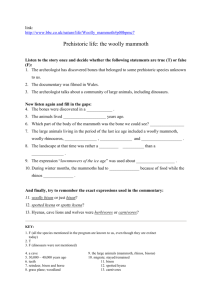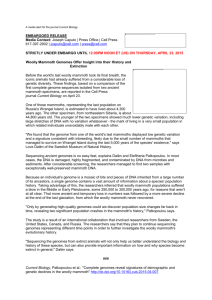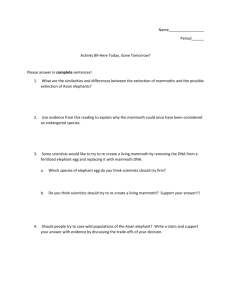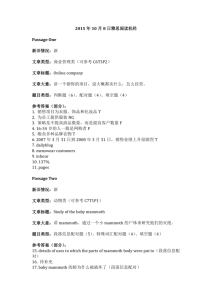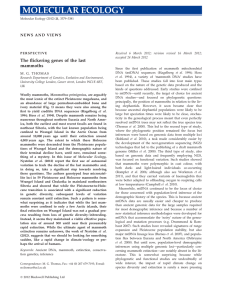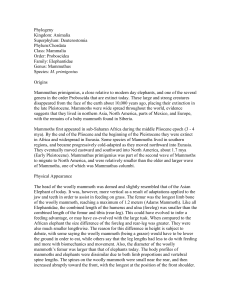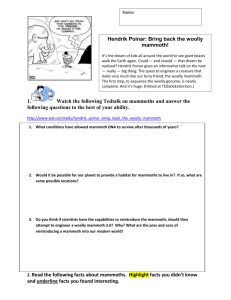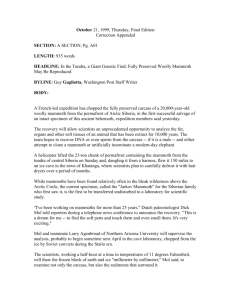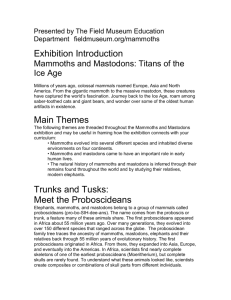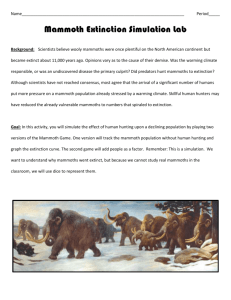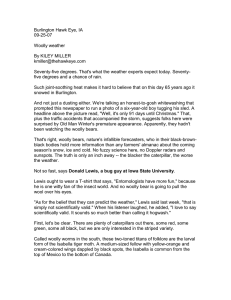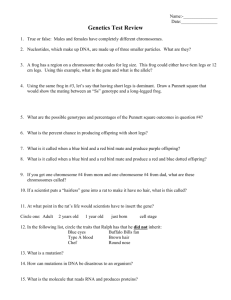File - Kylee Johnson`s E
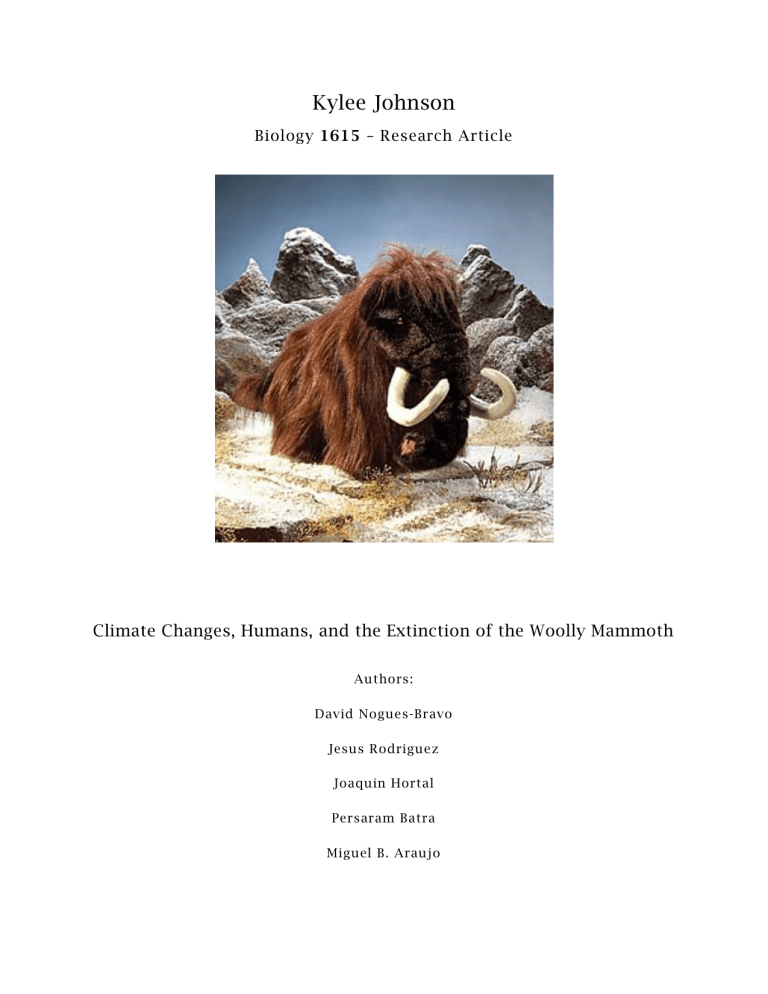
Kylee Johnson
Biology 1615 – Research Article
Climate Changes, Humans, and the Extinction of the Woolly Mammoth
Authors:
David Nogues-Bravo
Jesus Rodriguez
Joaquin Hortal
Persaram Batra
Miguel B. Araujo
Woolly mammoths inhabited the earth over 30 ky BP (300,000 years) ago, living primarily in
Eurasia and North America from the Pleistocene Age (300,000 years before present) until vanishing during the Holocene Age (3,600 years before present). The mammoths were herbivores, living in the cool, dry tundras of the Northern Hemisphere. The woolly mammoth was a cold-adapted species, yet they had survived prior warming periods and dramatic climate changes. This suggests that a more plausible cause may include human expansion.
The debate as to why woolly mammoths became extinct has centered around environmental and human-induced effects. Scientists David Nogues-Bravo, Jesus Rodriguez, Joaquin
Hortal, Persaram Batra, and Miguel B. Araujo combined both the climate envelope model and a population model including treatment of woolly mammoth-human interaction to try to learn more about why these creatures vanished. This combination included climate changes during various time periods as well as increase in hunting/human pressure throughout those time periods to explain what may have lead to this species extinction in Eurasia.
In this study, researchers Nogues-Bravo, Rodriguez, Hortal, Batra, and Araujo combined paleo-climate stimulations, climate envelope models (details the climate associate d with the known distribution of a species, and estimate that envelopes position under different climate change scenarios), and a population model including explicit treatment of woolly mammoth human interactions. The goal of this study is to measure the extent to which ea ch factor, or
combination of these factors, may have been responsible for the extinction of woolly mammoths.
These researchers combined a climate envelope model with a dynamic population model to explore to what extent the extinction of this species may have been driven by the collapse of its suitable climate conditions and the growth of human hunting. The climate envelope of woolly mammoths was characterized using statistics associated with fossil records and palaeo-climate simulations.
They first evaluated any climatic conditions which may have changed, affecting the woolly mammoth populations during these time periods. They found that the climatic preferences did not differ significantly during the tested time periods (42 ky BP, 30 ky Bp, and 21 ky
BP). They split these suitable climatic conditions into quartiles and used a suitability gradient to measure the climatic difference between each of the woolly mammoth’s records and average climatic conditions.
Researchers Nogues-Bravo, Rodriguez, Hortal, Batra, and Araujo used carbon-dated fossil records from four time periods (~42 ky BP, 30 ky BP, 21 ky BP, and 6 ky BP) to characterize and project the climatic envelope. The assumption was made that the climate envelope of mammoths can be described reasonably using 3 variables: average temperature of the coldest month, average temperature of the warmest month, and the annual precipitation. This data was collected for several time periods (126 ky BP, 42 ky BP, 30 ky BP, 21 ky BP, and 6 ky
BP).
These scientists modeled the envelope combining data from periods 42 ky BP, 30 ky BP, and
21 ky BP; The suitable climatic conditions for 126 ky BP and 6 ky BP were also projected.
Using these results they estimated the decrease in number of woolly mammoths, and were able to model the hunting intensity needed to extinguish the species during 4 periods: 42 ky
BP, 30 ky BP, 21 ky Bp, and 6 ky BP.
The results show that the most habitable geographic area occurred between 126 ky BP and 42 ky BP (about 8.1 square kilometers), significantly decreasing thereafter. At the 21 ky BP period, only 3.8 square kilometers remained. By the 6 ky BP period, only .8 million square kilometers of suitable climatic conditions remained. The loss in habitable geographic area would be devastating to the mammoth population, leading to smaller populations due to the habitat restrictions.
To model the needed hunting intensity, researchers created a formula which combined calculations for the number of woolly mammoths required to be killed per person per year, and the percentage of mammoth population that must be killed to lead the species to extinction. They found that the number of mammoths killed per person per year were similar during the 42 ky BP and 30 ky BP periods, but began decreasing rapidly by 21 ky BP.
Researchers found the number became very low once they reached 6 ky BP, finding that only
.37 individuals killed per person per year would be enough to kill the species. In other words, if just 1 woolly mammoth were killed every 3 years per person, that would be sufficient to drive the entire woolly mammoth species to extinction.
The final results show that habitable conditions occurring in Eurasia progressively collapsed after 42 ky BP. Over 89% of the species habitable geographic range vanished between 42 ky
BP and 6 ky BP with habitable areas being restricted mainly to Artic Siberia (Wrangel
Island, Artic Siberia, is where the latest Holocene specimens have been discovered, and is believed to be the final location woolly mammoths inhabited.). The results also indicate that the collapse of the climatically suitable area created a significant drop in the population size of mammoths, making them more vulnerable to hunting pressure from the expanding human populations. These results, combined with the decreased number of kills needed to eliminate the species became a deadly combination for woolly mammoths, making it increasingly difficult for the species to survive.
In conclusion, these researchers were able to determine that their hypothesis was supported by their research. They found that the collapse of climatically suitable areas and expansion of human population impacts are most likely to have been the lethal combination, setting the time and place for the extinction of woolly mammoths.
